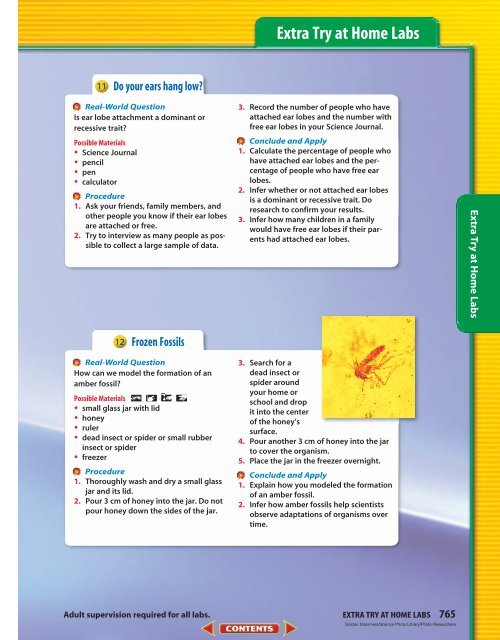Student Resources—746
Student Resources—746
Student Resources—746
Create successful ePaper yourself
Turn your PDF publications into a flip-book with our unique Google optimized e-Paper software.
Do your ears hang low?<br />
Real-World Question<br />
Is ear lobe attachment a dominant or<br />
recessive trait?<br />
Possible Materials<br />
• Science Journal<br />
• pencil<br />
• pen<br />
• calculator<br />
Procedure<br />
1. Ask your friends, family members, and<br />
other people you know if their ear lobes<br />
are attached or free.<br />
2. Try to interview as many people as possible<br />
to collect a large sample of data.<br />
Frozen Fossils<br />
Real-World Question<br />
How can we model the formation of an<br />
amber fossil?<br />
Possible Materials<br />
• small glass jar with lid<br />
• honey<br />
• ruler<br />
• dead insect or spider or small rubber<br />
insect or spider<br />
• freezer<br />
Procedure<br />
1. Thoroughly wash and dry a small glass<br />
jar and its lid.<br />
2. Pour 3 cm of honey into the jar. Do not<br />
pour honey down the sides of the jar.<br />
Adult supervision required for all labs.<br />
Extra Try at Home Labs<br />
3. Record the number of people who have<br />
attached ear lobes and the number with<br />
free ear lobes in your Science Journal.<br />
Conclude and Apply<br />
1. Calculate the percentage of people who<br />
have attached ear lobes and the percentage<br />
of people who have free ear<br />
lobes.<br />
2. Infer whether or not attached ear lobes<br />
is a dominant or recessive trait. Do<br />
research to confirm your results.<br />
3. Infer how many children in a family<br />
would have free ear lobes if their parents<br />
had attached ear lobes.<br />
3. Search for a<br />
dead insect or<br />
spider around<br />
your home or<br />
school and drop<br />
it into the center<br />
of the honey’s<br />
surface.<br />
4. Pour another 3 cm of honey into the jar<br />
to cover the organism.<br />
5. Place the jar in the freezer overnight.<br />
Conclude and Apply<br />
1. Explain how you modeled the formation<br />
of an amber fossil.<br />
2. Infer how amber fossils help scientists<br />
observe adaptations of organisms over<br />
time.<br />
EXTRA TRY AT HOME LABS 765<br />
Sinclair Stammers/Science Photo Library/Photo Researchers<br />
Extra Try at Home Labs
















